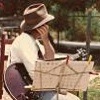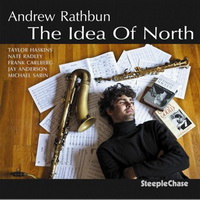Home » Jazz Articles » Live Review » Anthony Davis Ensemble Live at Dizzy's San Diego, Februa...
Anthony Davis Ensemble Live at Dizzy's San Diego, February 20, 2011
Dizzy's, San Diego
San Diego, CA
February 20, 2011
 Composer and pianist Anthony Davis is a modern day renaissance man. Not only is he a master of multiple jazz disciplines, he also has composed several critically acclaimed operas. His classical works have often dealt with controversial subjects, such as Tania, (about Patty Hearst), and Amistad (the famous 1839 slave-ship rebellion). Davis, who has spent the last several years teaching at UCSD's justifiably lauded music department, has diverse interests which have led him to compose one of the landmark recordings of the late 20th Century, Episteme (Gramavision, 1981), a disc that fused a new-music jazz octet with Balinese Gamelan influenced charts, and also to appear as the pianist in the Anthony Braxton quartet, on the album Six Compositions Quartet (Antilles, 1982).
Composer and pianist Anthony Davis is a modern day renaissance man. Not only is he a master of multiple jazz disciplines, he also has composed several critically acclaimed operas. His classical works have often dealt with controversial subjects, such as Tania, (about Patty Hearst), and Amistad (the famous 1839 slave-ship rebellion). Davis, who has spent the last several years teaching at UCSD's justifiably lauded music department, has diverse interests which have led him to compose one of the landmark recordings of the late 20th Century, Episteme (Gramavision, 1981), a disc that fused a new-music jazz octet with Balinese Gamelan influenced charts, and also to appear as the pianist in the Anthony Braxton quartet, on the album Six Compositions Quartet (Antilles, 1982). As a jazz pianist, Davis takes elements of Duke Ellington, Thelonious Monk, and Cecil Taylor, along with the harmonic concept of Art Tatum. There is also a Herbie Hancock influence, particularly in his use of space in ensemble work. He incorporates these inspirations and mixes in the classical influences of Stravinsky, Ligeti and Debussy into his own personal language.
The concert at Dizzy's marked a rare San Diego appearance for the pianist, as well as a celebration of his 60th birthday. For this event he gathered several operatic sopranos, and the remarkable bassist Mark Dresser. As a special treat, he invited two long-time collaborators from New York: the virtuoso multi-instrumentalist J.D. Parran, and alto saxophonist / electronics master Earl Howard.
The concert began with a feature for his wife, soprano Cynthia Aaronson, on an aria from his opera Tania, titled "Who Will Play Me?" Dresser began things with a tight, swinging bass vamp, and Davis comped with sparse chords, eventually opening up with Monk-like repetitions and bluesy trills. Aaronson's voice was dead on, capturing the tricky melody with grace.
Next, Davis brought out a show-stopping original composition from 1975, "Of Blues and Dreams." It started out as a kind of free rumination, Davis' rumbling piano melding with Dresser's double glissandi. Meanwhile, Howard's alto and Parran's bass clarinet traded mournful sounds that resembled seagulls circling overhead and then began volleying lines to each other that got incrementally longer each time. Davis began injecting long arpeggiated piano flourishes into the mix, adding a joyous component previously missing. Seamlessly, the ensemble morphed into a second written section emphasizing a bluesy swing dynamic, which Dresser highlighted by slapping the downbeats on his bass. That led into a furious free-for-all, which sounded similar to Mingus' experiments in group improvisation.
Emerging from the clamor, Parran took over with a solo filled with Dolphy-esque cries and gurgling multiphonics. Dresser pedaled, offsetting Davis' insistent clusters, then the pianist launched into a powerful, dissonant solo with rapid fire strands of right hand melodic fragments. Turning on a dime, the ensemble drew down to a closing melody that fused blues and spiritual elements.
Ensemble-wise, it was a tough act to follow, and Davis wisely chose that moment for an extended piano feature: "Goddess Of The Water Variations," an aria from his opera Amistad. He alternated left handed bass statements with a evocative rubato introduction, and it wasn't hard to picture something glimmering just below the surface. Gradually the piece grew more agitated with clanging trills and cascading arpeggios, offset by occasional thunderous outbursts of the left hand. It was easy enough to imagine this piece presaging the uprising to come.
Davis introduced the last tune of the first set as a totally improvised free piece. Parran focused on the clarinet and Howard returned on alto, while Dresser began the piece with some of his astonishing "extended-techniques," including one that had both of his hands hammering totally independent lines going in opposite directions. The horns demonstrated a degree of familiarity that was obviously born from experience, because their lines intertwined and dovetailed around each other as if it were all written out.
While Parran eventually drifted into whiplashing Ornette Coleman-ish melody snippets, Howard responded with machine gun blasts of one note trills. The altoist finally broke the tension with a simple bah-dee-dah melody, repeated over and over. Dresser pedaled single notes, double stops and "worried" his G string with a wicked vibrato.
Davis, who had laid out for much of this piece, returned with strong, knotty, and ultimately unresolved multi-note injections which kept the tension ratcheted to an almost explosive degree. Without any obvious cue, the group as a whole executed a diminuendo down to a whisper, and the piece ended as mysteriously as it had begun.
The pianist then called for one of his frequent operatic collaborators, soprano Susan Naruki, to join the group for an investigation of his composition "Open Door" from a show he had written about the Joseph McCarthy debacle in American history. This one had a definite Ellington feel to it. Naruki has quite an instrument, and it was fascinating to watch her manipulate the muscles in her embouchure to reach for certain notes, which she hit, unerringly. The vocalist stuck around for a Davis aria from his opera Dream of the Spider (Art and Revolution), called, "This Is Like Love." Once again, the musical background supported the subject—in this case the Cuban Revolution—with an appropriately Latin tinge.
Davis then announced another open-ended tune, this one featuring Howard on synthesizer. He began coaxing what sounded like hundreds of keys rattling, then shifted into the sound of liquid boiling, while Dresser bowed eerie sul ponticello moans from his bass. Davis played inside the piano, muting strings with his left hand while striking keys with his right.
Parran, on flute, played repeating lines that were punctuated by jabs into the ether, in contrast to Dresser's wide arco glissandi. Special guest trombonist Michael Dessen of the fabulous free-jazz cooperative group Cosmologic was invited up, and he fit in seamlessly with the open-ended dynamic. Dessen began with slow, long, tones, fitting in wherever he could, then opened up with a fat, nasty solo that would make Roswell Rudd proud. Howard left the keyboard and joined in the fray, and for several moments, the group improvisation took on the nature of John Coltrane's epic Ascension (Impulse! 1965). Even when the din was at its most wild and orgiastic, everyone in the group was listening with virtuoso ears, because the moment Davis re-entered at a much softer level, the band's volume and intensity dropped to a hush. Fifteen or so minutes after it began, tinkling piano and long, held tones from the horns and bass wafted into the night.
The final piece of the evening was an excerpt of a concerto for bass clarinet master J.D. Parran from Davis' pen, titled, "You Have the Right to Remain Silent." This one started out with a free, rubato dreamscape. Howard returned to his synthesizer, sampling bits of Parran's playing, which he would inject back into the proceedings later.
Each member of the ensemble seemed to be leading the phrasing of a very oblique melody. As Howard slipped in bell-toned fragments, Davis posited ominous, stair-stepping intervals locked in a flow of tension and release. Parran began playing a very silky melody that was reminiscent of Ellington's "In A Sentimental Mood," but only until Howard started a dialogue with him, feeding back snippets of his own bass clarinet phrases.
The piece then shifted into a second movement, much more composed. There were definite echoes of Mingus in this hyper-rhythmic phase, with Davis laying down alternately lush and dissonant chords and the entire group reflecting a hard swing aesthetic. The band nailed down some unison rhythm hits, then Davis roared into his best solo of the evening, filled with rhapsodic themes butting up against blues commentary. Dresser's "time" playing was relentless and swinging, and his solo rippled with muscular stutter-stepping and crazy lines that he sang along with. Parran took over, keeping to the swing idea, gradually taking it out till the ensemble's intensity geared up, ending with a startling, unison bang.
Before the stunned crowd had a chance to recover, Parran began blowing the familiar strains of "Happy Birthday" which the audience completed, en masse.
Photo Credit:
Jeff Kaiser
Tags
Anthony Davis
Live Reviews
Robert Bush
United States
anthony braxton
duke ellington
Thelonious Monk
Cecil Taylor
Art Tatum
Herbie Hancock
Mark Dresser
J.D. Parran
Earl Howard
Michael Dessen
Cosmologic
Roswell Rudd
John Coltrane
PREVIOUS / NEXT
Support All About Jazz
 All About Jazz has been a pillar of jazz since 1995, championing it as an art form and, more importantly, supporting the musicians who make it. Our enduring commitment has made "AAJ" one of the most culturally important websites of its kind, read by hundreds of thousands of fans, musicians and industry figures every month.
All About Jazz has been a pillar of jazz since 1995, championing it as an art form and, more importantly, supporting the musicians who make it. Our enduring commitment has made "AAJ" one of the most culturally important websites of its kind, read by hundreds of thousands of fans, musicians and industry figures every month.
























